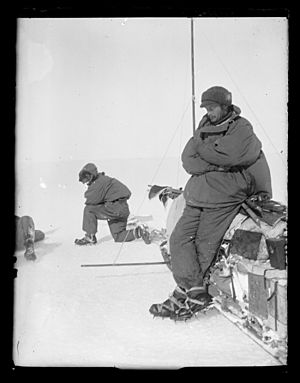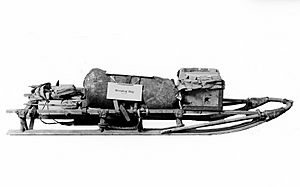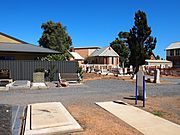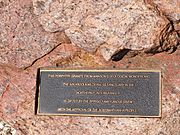Douglas Mawson facts for kids
Quick facts for kids
Douglas Mawson
|
|
|---|---|
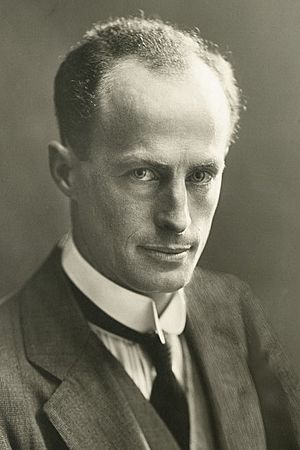
Mawson in 1914
|
|
| Born | 5 May 1882 |
| Died | 14 October 1958 (aged 76) Brighton, South Australia, Australia
|
| Nationality | Australian |
| Education | Fort Street Model School and University of Sydney, Sydney |
| Occupation | Geologist, chemistry demonstrator, Antarctic explorer, academic |
| Known for | First ascent of Mount Erebus First team to reach the South Magnetic Pole Sole survivor of Far Eastern Party Australasian Antarctic Expedition Mawson's Huts Mawson Plateau |
| Spouse(s) | Francisca Paquita Delprat (1891–1974), married 1914 |
| Children | Patricia (1915–1999) Jessica (1917–2004) |
| Awards | Fellow of the Royal Society Bigsby Medal (1919) Clarke Medal (1936) Polar Medal(1909, 1934) |
Sir Douglas Mawson (5 May 1882 – 14 October 1958) was an Australian geologist and explorer. He played a big part in exploring the Antarctic. He was one of the main leaders during the "Heroic Age of Antarctic Exploration." This was a time when many brave explorers went to the South Pole.
Mawson was born in England. He moved to Australia when he was a baby. He studied mining and geology at the University of Sydney. In 1905, he became a teacher at the University of Adelaide.
His first trip to Antarctica was with Ernest Shackleton's Nimrod Expedition (1907–1909). On this trip, he and his team were the first to reach the South Magnetic Pole. They also climbed Mount Erebus, a volcano.
After this, Mawson led his own journey, the Australasian Antarctic Expedition (1911–1914). His team explored huge areas of Antarctica. They collected samples and made important scientific discoveries. Mawson was the only survivor of a three-person team. He had to travel alone for over a month to get back to base.
Mawson was made a knight in 1914. He continued to work in geology. He led another Antarctic trip from 1929 to 1931. This trip helped Australia claim land in Antarctica. Mawson is remembered in many ways. His picture was even on the Australian $100 note.
Contents
Early Life and Studies
Douglas Mawson was born on 5 May 1882. His parents were Robert Ellis Mawson and Margaret Ann Moore. He was born in Shipley, West Yorkshire. When he was less than two years old, his family moved to Australia. They first lived in Rooty Hill, New South Wales. Later, they moved to Glebe, New South Wales in 1893.
He went to Forest Lodge Public School and Fort Street High School. He then studied at the University of Sydney. In 1902, he earned a degree in engineering.
Early Work as a Geologist
In 1903, Mawson became a geologist for a trip to the New Hebrides. This place is now called Vanuatu. His report on the geology there was very important. He also wrote a paper about geology in Mittagong, New South Wales.
Two professors, Edgeworth David and Archibald Liversidge, greatly influenced him. In 1905, he started teaching about rocks and minerals at the University of Adelaide. He also found and described a new mineral called davidite.
First Antarctic Adventure: The Nimrod Expedition
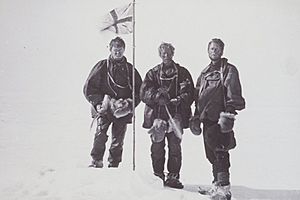
Mawson joined Ernest Shackleton's Nimrod Expedition to Antarctica. He planned to stay only for the first summer. But he and his teacher, Edgeworth David, stayed an extra year.
During this time, they made history. With Alistair Mackay, they were the first to climb Mount Erebus. This is a large volcano in Antarctica. They also trekked to the South Magnetic Pole. At that time, it was located over land.
Leading His Own Expedition: The Australasian Antarctic Expedition
In 1910, Mawson decided to lead his own expedition. He turned down an offer to join Robert Falcon Scott's trip. Mawson wanted to explore the part of Antarctica south of Australia. This area was mostly unknown.
His goals were to map the land and study science. He also wanted to visit the South Magnetic Pole. Mawson quickly raised money for the trip. He got help from the British and Australian governments. Businesses interested in mining and whaling also helped.
The expedition ship was called the SY Aurora. Captain John King Davis commanded it. They left Hobart on 2 December 1911. On 8 January 1912, they landed at Cape Denison. This place is in Commonwealth Bay. They set up their main base there.
Cape Denison was incredibly windy. The average wind speed was about 80 kilometers per hour (50 mph). Some winds were even faster than 320 kilometers per hour (200 mph). Mawson called it "the windiest place on Earth." The team built huts and spent the winter there. They faced almost constant blizzards.
Mawson had hoped to explore by air. He brought the first airplane to Antarctica. But the plane was damaged before the trip. So, they planned to use it as a tractor on skis. However, the engine did not work well in the cold. It was removed and sent back. The plane's body was left behind. In 2009, parts of it were found again.
Mawson's team explored using five groups from the main base. Two groups worked from a western base. Mawson himself was in a three-man team. This team was called the Far Eastern Party. With Xavier Mertz and Lieutenant Belgrave Ninnis, he headed east. They left on 10 November 1912. Their goal was to map King George V Land.
Surviving Alone
After five weeks, the Far Eastern Party was doing well. They were mapping the coastline and collecting rock samples. They were crossing the Ninnis Glacier. Ninnis fell into a deep crack in the ice called a crevasse. His body weight likely broke the snow bridge covering it. Six of their best dogs, most of their food, and their tent disappeared into the crevasse. Ninnis was never seen again.
Mawson and Mertz immediately turned back. They had only enough food for one week for two men. They had no dog food. They traveled for 27 hours straight to get a spare tent cover. They made a frame for it using skis.
Both men quickly became very sick. They suffered from dizziness, nausea, and stomach pain. They also lost skin, hair, and nails. Their eyes and skin turned yellow. Mawson noticed Mertz getting much worse. Mertz seemed to lose the will to move. He had diarrhea and became confused. One time, Mertz bit off the tip of his own finger. He then became violent. Mawson had to hold him down to protect their tent. Mertz had more seizures. He fell into a coma and died on 8 January 1913.
It was not known then that Siberian Husky dog liver has very high levels of vitamin A. Too much vitamin A can harm humans. Mawson and Mertz had eaten the livers of their dogs for food. It is thought they ate enough to get sick from too much vitamin A. Mertz may have eaten more liver than Mawson. This is because he found the tough muscle meat hard to eat.
Mawson continued the last 160 kilometers (100 miles) alone. During his journey back, he fell into another crevasse. His sledge got stuck in the ice above him. This saved him. He managed to climb out using the harness that connected him to the sled.
When Mawson finally reached Cape Denison, his ship, the Aurora, had left just hours before. The ship was called back by radio. But bad weather stopped the rescue. Mawson and six men who had stayed behind waited another year. They were rescued in December 1913.
In his book, Home of the Blizzard, Mawson wrote about his experiences. His team explored large areas of the Antarctic coast. They described its geology, plants, animals, and weather. They also found the exact location of the South Magnetic Pole.
Later Life and Legacy
Mawson married Francisca Adriana (Paquita) Delprat on 31 March 1914. They had two daughters, Patricia and Jessica. Also in 1914, he was made a knight.
After World War I, he returned to the University of Adelaide in 1919. He became a full professor of geology in 1921. He greatly helped Australian geology. He led another expedition, the British Australian and New Zealand Antarctic Research Expedition, from 1929 to 1931. This trip led to the creation of the Australian Antarctic Territory in 1936. He also spent a lot of time studying the geology of the Flinders Ranges in South Australia.
Mawson retired from teaching in 1952. He died at his home in Brighton, South Australia on 14 October 1958. He was 76 years old.
Many things are named after Sir Douglas Mawson. These include:
- Mawson Peak on Heard Island.
- Mount Mawson in Tasmania.
- Mawson Station, an Australian research base in Antarctica.
- Dorsa Mawson on the Moon.
- The geology building at the University of Adelaide.
- Suburbs in Canberra and Adelaide.
- A campus of the University of South Australia.
- The main street of Meadows, South Australia.
- Sports houses at several schools.
His image has appeared on Australian postage stamps. From 1984 to 1996, his picture was on the Australian $100 note. In 2012, he was featured on a $1 coin.
The Mawson Trail in South Australia is also named after him. A small planet, 4456 Mawson, is named in his honor.
Images for kids
-
Bust of Mawson on North Terrace, Adelaide, South Australia in front of the University of Adelaide
Burial
Sir Douglas Mawson was buried at St Jude's Church in Brighton, South Australia in 1958. 35°1′1.99″S 138°31′26.89″E / 35.0172194°S 138.5241361°E
-
Plaque acknowledging gift of the boulder from Arkaroola marking Mawson's grave, from the Sprigg family
See also
 In Spanish: Douglas Mawson para niños
In Spanish: Douglas Mawson para niños


